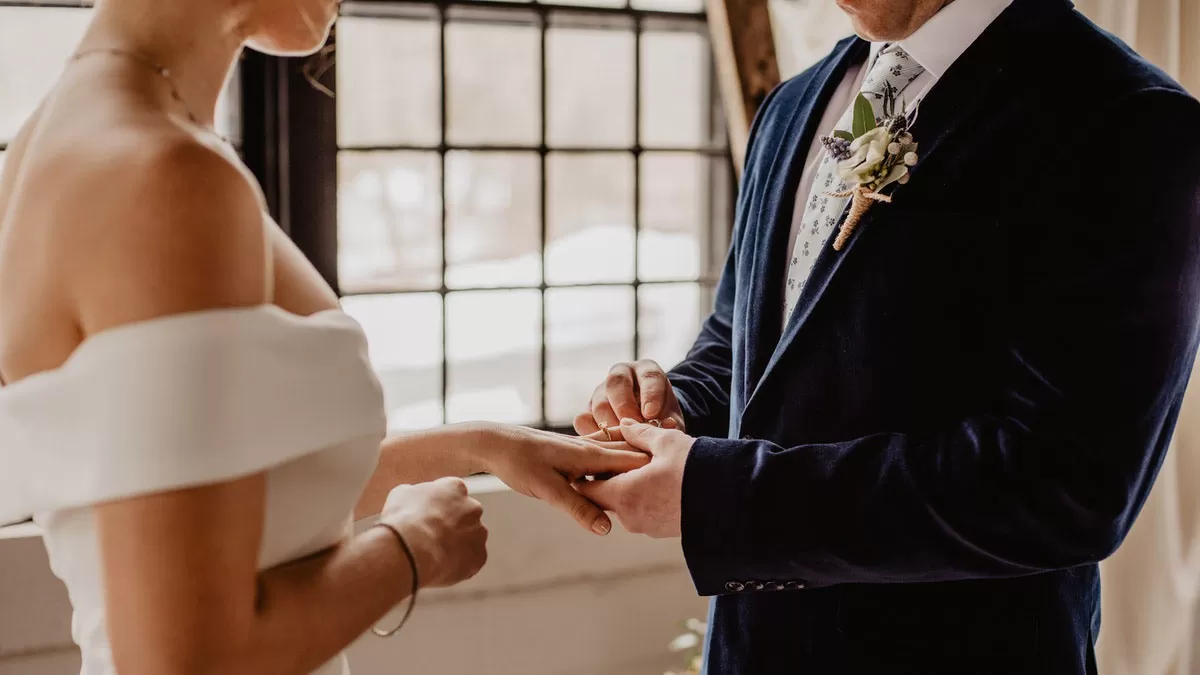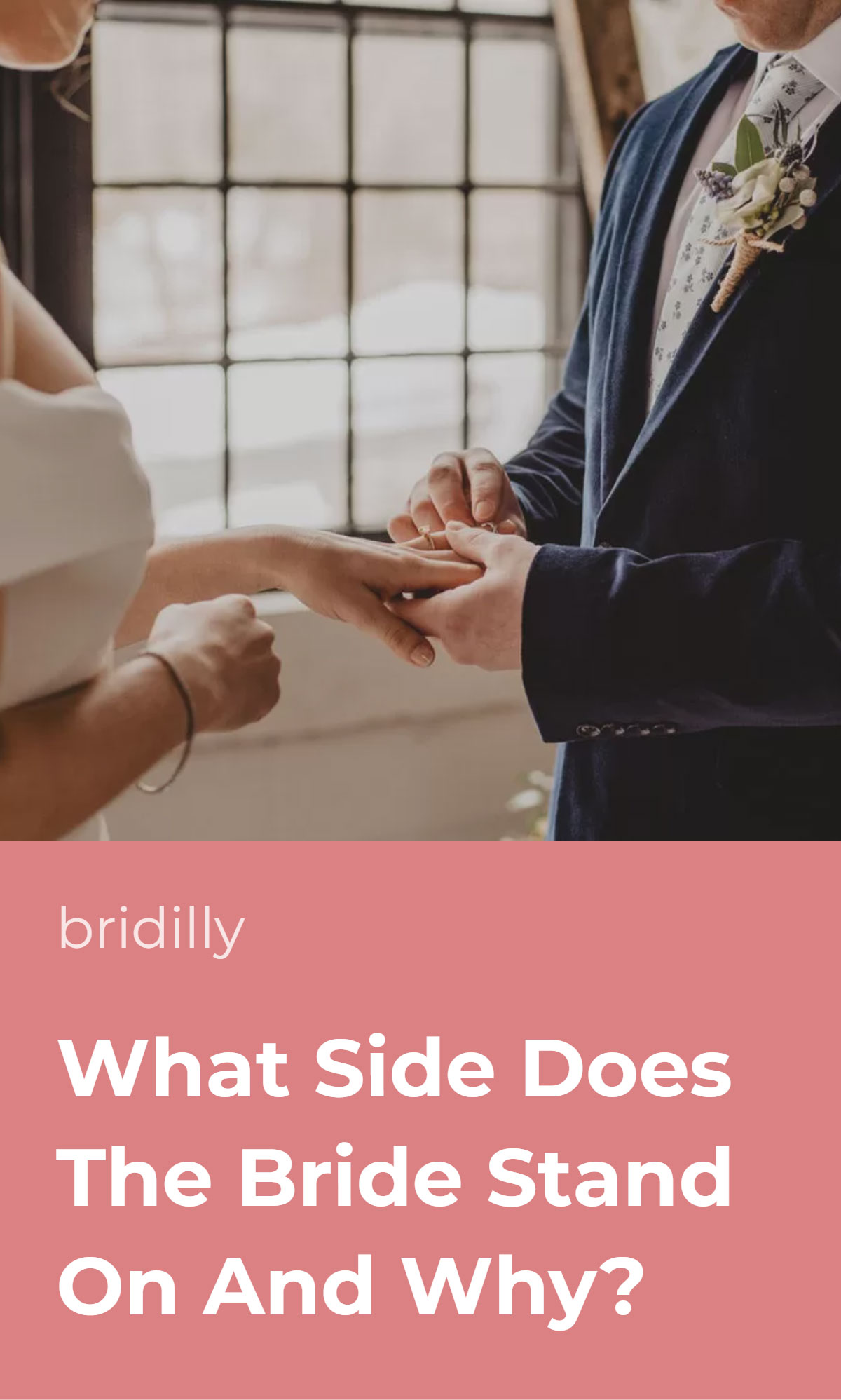When the wedding ceremony is getting closer, many women start to wonder – what side does the bride stand on? Most importantly, why?
The answer to this question lies in centuries-old traditions, religious scriptures, and your cultural background.
The rules are strictly set for religious ceremonies, be it Catholic, Orthodox, Jewish, Buddhist, or Hindu weddings. For civil ceremonies, however, the couple’s positioning is less crucial.
Traditionally, the bride stands to the left of the groom in American ceremonies. However, no one forces you to follow this practice if you don’t want to.
You may have practical reasons to switch the sides or may not like the reasoning behind the tradition of the bride standing on the left. At the end of the day, your ceremonial positioning is solely your choice.
Table of Contents [show]
American Tradition
In the U.S., the bride traditionally stands on the left side of the altar and the groom on the right side. This practice has been around for centuries, but it doesn’t mean that everyone marrying in the U.S. must follow it.
The bride standing on the left in American and European traditions is not a law but a tribute to history that you may or may not want to pay. You can switch things up if you want to unless you’ve chosen a religious ceremony.
The truth is, many couples in the U.S. observe this tradition simply because that’s what they are used to and never gave it a thought. For many brides, the side they’re standing on doesn’t matter.
But if you have practical or symbolic points in favor of standing on the opposite side, you’re free to do so. Perhaps, the only person who could stop you from switching sides is the groom.
Symbolic Protection
The tradition of the bride standing on the left side stems from the Middle Ages. At that time, marriages by capture weren’t uncommon, meaning that a man could kidnap any woman he would like to marry.
Apparently, men had to keep a sword in their right hand to protect their bride from getting kidnapped by someone else at the last minute. Those poor brides – being kidnapped twice in a day should be stressful.
Such an origin may easily make the tradition unappealing for many brides – after all, you’ve likely chosen your partner willingly. However, some historians claim that the practice was observed even in willful marriages.
The groom keeping a sword in his right hand could have served merely as a symbolic gesture of protection. If the marriage was willful, there was no need to defend the bride from other suitors wishing to whisk her away.
In other words, don’t hurry to cease the tradition and switch sides because it was observed in marriages by capture. The practice carries a beautiful symbolism regardless of historical implications.
The Right Hand in the Bible
Have you ever heard the phrase “to be someone’s right hand”? It’s usually said about an irreplaceable, valuable person, be it a chief assistant at work, your best friend, or your partner.
This phrase has religious roots – “right hand” occurs in the Bible nearly 200 times, so it certainly has a special significance. The right hand signifies strength and honor.
The right-hand side is also the place of authority to whoever sits on the royal throne, and in the Bible, Jesus has made references to sitting “at the right hand of the power of God.”
Furthermore, when two of Jesus’ disciples came to him asking to sit from both sides of him, he responded with, “to sit at my right hand or at my left is not mine to grant, but it is for those for whom it has been prepared.”
Other Biblical implications involve the Lord blessing people and shattering enemies with his right hand, never the left.
The bride standing to the left from the groom makes him her “right hand.” This symbolically proclaims the groom the head of the house, granting him authority but also the liability of protecting the bride.
Since each side has a special significance in Catholicism, you shouldn’t switch sides in church ceremonies unless you aren’t Catholic, as the tradition isn’t universal for all religions.
Guest Arrangement
Symbolism is great, but there are also practical considerations.
Traditionally, guests from the bride’s side sit on the left, and guests from the groom’s side sit on the right. However, sometimes, the wedding guest seating chart is created before the couple has chosen sides.
If your wedding planner has already made a seating chart or even printed the cards, changing everything may take unnecessary time (and money). If your family and friends are sitting on the right, you may want to stand on the right, too.
Of course, most wedding planners know the tradition or would consult with you on the topic beforehand. Still, mistakes happen, and it’s up to you to decide whether the side you’re standing on matters.
Your Good Side
None of us are perfectly symmetrical, so each one has a “good side.” Think of how you usually turn your head when taking pictures. Do you like yourself more from the left or from the right?
You will likely have a photographer capturing your ceremony, or at least your aunt shooting everything on her phone. Even if you have a “no-camera” policy, remember that the guests will see only one of your sides during the ceremony.
Being turned with your best angle to the audience and camera will give you the confidence many brides lack when standing at the altar.
A wedding is a happy yet stressful event, and you don’t want to add to the stress thinking that you could’ve looked better.
Other Practical Considerations
This may not be obvious, but your hairstylist can have a major input in your wedding ceremony positions. For instance, if you will have an intricate asymmetric hairstyle, you may want to showcase it to the audience from the best side.
And if your hair will be cascading down your right-hand side, you may want to stand on the right to avoid your face being fully concealed behind the hair.
Another practical consideration is the sun. Brides tend to have heavy makeup.
It’s meant to last for the entire day, but an oily glow is practically inevitable if you stand under direct sunlight sweating in a tight dress and under multiple layers of foundation.
Thus, if your wedding is in the summer or spring and the sun is falling on the left side of the altar, ask your partner to switch sides. Of course, only if he doesn’t mind standing in the sun.
It’s best to visit your wedding venue beforehand at about the same time of the day to determine how the sun falls through windows and pick the right spot for the both of you.
In Other Cultures
While in Western culture, the bride stands on the left side, it isn’t a universal tradition. For instance, in Jewish wedding ceremonies, the bride stands on the right side.
As you already know, the right side is considered honored in Catholicism, so the groom standing on the right is granted authority and liability to protect his wife, adhering to conventional Catholic family rules.
However, during a Jewish ceremony, the bride and groom sign the Ketubah – a marriage contract outlining their obligations to each other.
Some scholars suggest that Ketubah was initially created to protect women from being abandoned by their husbands.
The Ketubah makes the bride and groom one whole and thus equal. So, both sides are honored, and nobody is given authority over the other one. That’s why the bride is standing on the right in Jewish ceremonies.
In many Asian countries, the marriage ceremony positioning often depends on whether the couple is Buddhist or Hindu.
In Buddhist weddings, the newlyweds sit in the middle of the top table during the reception, and the bride sits to the left from the groom.
In Hindu wedding ceremonies, women traditionally sit on the right. According to Hindu scriptures, the left side is connected to the deeds related to this worldly life, and the right side is connected to virtuous deeds.
Following this scripture, women should be to the left from their husbands when they do any worldly deeds, such as eating or sleeping. Women only sit to the right during religious rituals, such as Kanyadaan, yajna, or marriage.
In Orthodox tradition, the bride stands to the left from the groom during the wedding ceremony, just like in the Western world.
However, this practice carries a slightly different symbolism – the man should keep his woman next to his heart, thus on the left.
This wedding ceremony arrangement can also be explained by the positioning of icons in the Orthodox church – the icon of the Virgin Mary is on the left, and the icon of Jesus Christ is on the right of the altar.
During Soviet atheistic rule, however, the bride traditionally stood on the right – perhaps, to contradict religious traditions. An exception was only made if the groom was a military member to let him salute with his right hand.













No Comments Add one
Leave a Comment